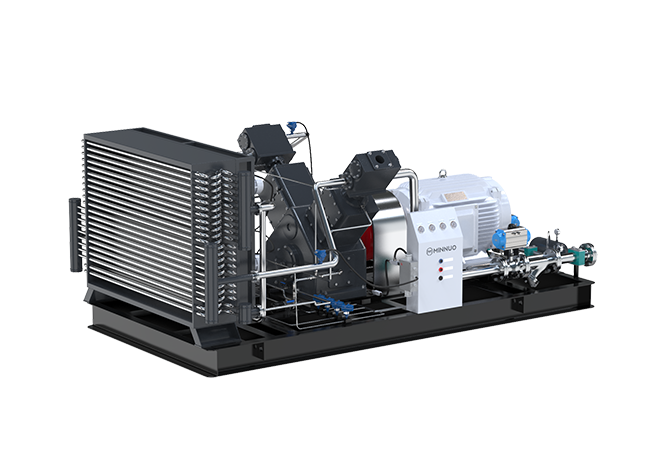Natural Gas Compression: The Comprehensive 2026 Guide to Plants & Solutions
Natural gas is a vital energy source, but its efficient transport and storage present a unique challenge: its low density. The solution is natural gas compression, a fundamental mechanical process that dramatically reduces the gas’s volume while raising its pressure. This guide delves into the essential role, technology, infrastructure (specifically gas compression plants), and cutting-edge gas compression solutions that power the modern energy landscape in 2026 and beyond.
1. The Core Concept: What is Natural Gas Compression?
At its simplest, natural gas compression is the act of forcing a large volume of gas into a smaller container. According to the ideal gas law ($PV = nRT$), when the volume ($V$) of a fixed amount of gas is decreased at a constant temperature, its pressure ($P$) must increase.
Key Definition:
Natural Gas Compression is the mechanical process of using a compressor to decrease the volume of natural gas, thereby increasing its kinetic energy and resulting pressure.
Why is Compression Necessary?
Compression serves several critical functions in the natural gas value chain:
- Transportation: Pipelines require high pressure (often 750 psi to 1500 psi) to push gas over long distances. Compression stations are strategically placed along the route to overcome frictional pressure loss.
- Storage: Compressed Natural Gas (CNG) allows for the efficient storage of large energy volumes in smaller physical spaces.
- Processing: Compression is often required before gas can be dehydrated or processed to remove impurities.
- Injection: High-pressure compression is used to re-inject natural gas into depleted reservoirs for enhanced oil recovery (EOR).
- Liquefaction (LNG): While not direct compression, the liquefaction process requires multiple stages of compression and cooling to reach the low temperatures needed to turn gas into a liquid for shipping.
2. Anatomy of Gas Compression Plants
A gas compression plant (or compression station) is the facility specifically designed and equipped to execute this process. These plants are the backbone of gas transmission networks.
Components of a Typical Plant:
| Component | Function |
| Compressor Unit | The heart of the plant, performing the compression (e.g., centrifugal, reciprocating). |
| Prime Mover | The engine or turbine that provides the power to drive the compressor (e.g., gas turbine, electric motor). |
| Cooler/Heat Exchanger | Removes the heat generated during compression (heat of compression). |
| Scrubbers/Separators | Remove liquids (like water or hydrocarbon condensate) that can damage the compressor. |
| Piping & Valves | Controls the flow and directs the high-pressure gas. |
Types of Compression Stations:
- Field Compression Stations: Located at the wellhead, boosting low-pressure gas for entry into the gathering lines.
- Pipeline Compression Stations: Placed every 40-100 miles along major transmission pipelines to maintain flow and pressure.
- Storage Compression Stations: Used to inject and withdraw gas from underground storage facilities.
3. Modern Gas Compression Solutions & Technologies (2026 Focus)
The industry is rapidly evolving, driven by demands for greater efficiency, reliability, and reduced environmental impact. Modern gas compression solutions often incorporate advanced technology.
A. Compressor Types:
- Reciprocating Compressors: Use a piston-cylinder arrangement (similar to a car engine). They are highly efficient for high-pressure, low-volume applications, commonly used at wellheads and high-pressure pipeline segments.
- Centrifugal Compressors: Use impellers to accelerate the gas. They are ideal for high-volume, continuous flow applications (e.g., mainline pipeline stations). Their complexity is balanced by their reliability and lower maintenance requirements.
- Screw Compressors: Use two rotating helical screws. Best for low-to-medium pressure applications.
B. Driving Force Innovations (Prime Movers):
In 2026, there is a significant shift towards more sustainable prime movers:
- High-Efficiency Electric Motors: Driven by grid power, these reduce on-site emissions, especially when the electricity is sourced from renewables.
- Advanced Gas Turbines: Newer turbine designs offer higher efficiency and lower $\text{NO}_x$ and $\text{CO}_2$ emissions.
C. Environmental & Digital Solutions:
- Zero-Emission Vents: Designing plants to capture and re-route methane that would otherwise be vented.
- Predictive Maintenance (AI/IoT): Sensors and AI algorithms monitor compressor vibration, temperature, and performance in real-time. This allows operators to predict failures before they happen, maximizing uptime and reducing maintenance costs—a key modern solution.
- Modular/Mobile Compression Units: Pre-packaged units that can be quickly deployed to various sites, offering flexible and scalable compression capacity.
4. Conclusion: Securing the Future of Gas Energy
Natural gas compression is not just a single step; it is an integrated, continuous process that underpins the reliability of our energy supply. From ensuring efficient transport in gas compression plants to deploying cutting-edge gas compression solutions like AI-driven maintenance and cleaner prime movers, the industry is dedicated to optimizing this essential technology. As global energy demands continue to rise, the efficiency and environmental footprint of gas compression will remain a critical focus for the energy sector.






 sales2:+86 17506119168
sales2:+86 17506119168

